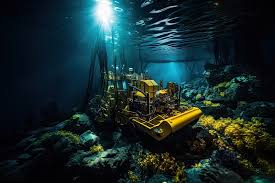Last month some very clever scientists published their findings on oxygen production on the seafloor. What is astonishing is that previously we’ve believed that free oxygen in the atmosphere and dissolved in the oceans had come almost exclusively from plants performing photosynthesis. But here at the lightless abysmal depths these scientists found levels of oxygen consistent with production of what they call “dark oxygen.” The discovery is yet another example of that eternal verity that we don’t know what we don’t know.
The findings—which were partly funded by deep sea mining interests—are now instantly under attack by those same interests. The reason can be found in the mechanism by which the oxygen is being produced. The scientists believe that the very minerals which the deep sea miners want to hoover up off the ocean floor are the ones facilitating what they call “seawater electrolysis.” Electrolysis is the process of freeing the hydrogen and oxygen atoms that make up water from each other using an electric current. The hypothesis is that electrolysis is taking place spontaneously as a result of the presence of copper and manganese nodules lying on the seabed.
The implications are profound if it turns out that this is a significant contributor to free oxygen on the planet. No one knows for sure, and the mechanism producing the oxygen has not yet been verified by other researchers. And that verification is precisely what the scientists say needs to happen. But that, of course, might delay any deep sea mining until the implications of that mining for dark oxygen are clarified.
I’ve written about deep sea mining before to discuss a bacterium that lives in the same area surveyed by the scientists mentioned above. The Clarion-Clipperon Zone is a vast stretch of the Pacific Ocean located between Hawaii and Mexico and teeming with life including a bacterium that may be responsible for sequestering 10 percent of all the carbon dioxide absorbed by the oceans. (The oceans together absorb about one-quarter of all carbon dioxide emitted into the atmosphere—absorption which is causing the acidification of the oceans and thereby creating other problems.)
In a 2017 piece I asked what species are we sure we can survive without. We don’t know whether we can survive without this bacterium. We don’t know if we can survive in the long run without all the species supported by dark oxygen. And, of course, there are all those species we are destroying through chemical poisoning, loss of habitat and other means that may or may not be essential to our survival. Some of those species undoubtedly have never been catalogued and studied. We don’t know they exist and we don’t know we are losing them.
Not knowing what we don’t know would not be so consequential if humans had not become the dominant geological force on the plant. Our blundering across the landscape and now the seascape endangers us and all the creatures around us. We continue to live as if the scale of our activities is too small to affect the functioning of the biosphere even though it is blatantly obvious that that notion has long since stopped being true. The discovery of dark oxygen is one more reminder that we will continue to be surprised by the depths of our ignorance.

 Iran Energy News Oil, Gas, Petrochemical and Energy Field Specialized Channel
Iran Energy News Oil, Gas, Petrochemical and Energy Field Specialized Channel



